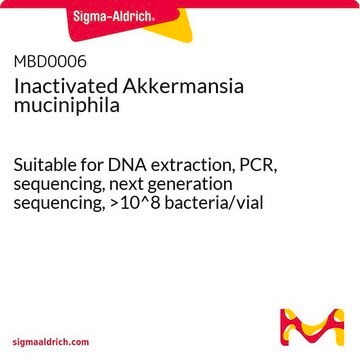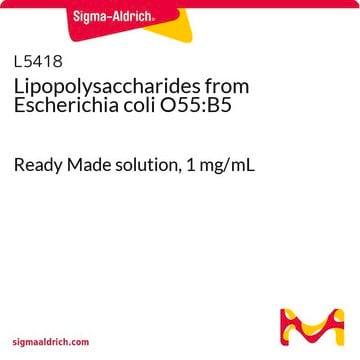SBR00027
Lipopolysaccharides from Akkermansia muciniphila
Purified by phenol extraction
About This Item
Produtos recomendados
fonte biológica
(Akkermansia muciniphila)
Nível de qualidade
forma
lyophilized powder
cor
white to faint yellow
solubilidade
water: 1 mg/mL, faintly hazy to hazy, colorless to light yellow
temperatura de armazenamento
2-8°C
Descrição geral
Aplicação
- to impair barrier functions of Caco-2 cell monolayers tight junction
- cocultured along with A. muciniphila to study its effects on the NLR family pyrin domain containing 3 (NLRP3) expressions in Raw264.7 cells
- to activate HepG2 cells as an endotoxin together with palmitic acid (PA)
Ações bioquímicas/fisiológicas
A. muciniphila degrades mucus and utilizes it as a carbon/nitrogen source. Consequently, the host produces additional mucus while the bacterium produces oligosaccharides and Short Chain Fatty Acids (SCFAs) that can be utilized by the host and trigger the immune system. An additional protective effect of the SCFA is stimulation of mucus-associated microbiota growth, that serves as a barrier against penetration of pathogens to intestinal cells.,
A. muciniphila was crowned as the next-generation beneficial microbe. Several reports have indicated that A. muciniphila affects glucose metabolism, lipid metabolism, and intestinal immunity. In addition, decreasing levels of A. muciniphila are related to the development of some diseases such as metabolic disorders and inflammatory diseases (obesity, type 2 diabetes, inflammatory bowel disease (IBD), autism and atopy. Weir et al. found a correlation between low level of A. muciniphila and colorectal cancer. Shigemetzu Y et al. found that A. muciniphila acts as a regulator of the response to PD-1 blockade which is used for anti-cancer immunotherapy. A. muciniphila induce dendritic cells to secrete IL-12, that is a critical component of the anti-cancer effect of PD-1 blockade.
LPSs from A. muciniphila stimulate NF-κB dependent secreted embryonic cell alkaline phosphatase (SEAP) production via TLR4. In addition, it induces IL-8, IL-6 and minimal amounts of IL-10 and TNF-α in peripheral blood mononuclear cells (PBMCs). A. muciniphila stimulation of IL-8 production by enterocytes was shown to be significantly (100 fold) lower than E. coli stimulation. Low proinflammatory activity keep the mucosa-associated immune system alerted at an appropriate level for generation of mucosal homeostasis.
Outras notas
Palavra indicadora
Danger
Frases de perigo
Declarações de precaução
Classificações de perigo
Acute Tox. 2 Oral
Código de classe de armazenamento
6.1A - Combustible acute toxic Cat. 1 and 2 / very toxic hazardous materials
Classe de risco de água (WGK)
WGK 3
Ponto de fulgor (°F)
Not applicable
Ponto de fulgor (°C)
Not applicable
Choose from one of the most recent versions:
Certificados de análise (COA)
Sorry, we don't have COAs for this product available online at this time.
If you need assistance, please contact Atendimento ao cliente
Já possui este produto?
Encontre a documentação dos produtos que você adquiriu recentemente na biblioteca de documentos.
Artigos
Explore the structure, function, and diverse applications of Lipopolysaccharides. Discover their role in bacteria, serological specificity, and research potential.
Nossa equipe de cientistas tem experiência em todas as áreas de pesquisa, incluindo Life Sciences, ciência de materiais, síntese química, cromatografia, química analítica e muitas outras.
Entre em contato com a assistência técnica





